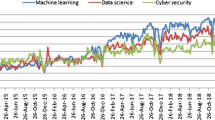Abstract
Due to the widespread usage of computer resources in everyday life, cyber security has been highlighted as one of the main concerns of governments and authorities. Data mining technology can be used for prevention of cyber breaches in different ways and Cyber Situational Awareness (CSA) can be improved based on analyzing past experiences in terms of cyber-attacks. This paper aims to investigate and review current state of CSA improvement through data mining techniques and predictive analytic and offers possible methodology based on data mining techniques which can be used by cyber firms in order to secure themselves against future cyber threats.
Access this chapter
Tax calculation will be finalised at checkout
Purchases are for personal use only
Similar content being viewed by others
References
Aaviksoo, J.: Cyber-terrorism. Vital Speeches Day 74(1), 28 (2008)
Ahlemeyer-Stubbe, A., Coleman, S.: A Practical Guide to Data Mining for Business and Industry. Wiley, New York (2014)
Ahn, S., Kim, N., Chung, T.: Big Data Analysis System Concept for Detecting Unknown Attacks (2014)
Al-janabi, K.B.S.: A proposed framework for analyzing crime data set using decision tree and simple k-means mining algorithms. J. Kufa Math. Comput. 1(3), 8–24 (2011)
Antonik, J.: Decision management. In: Military Communications Conference (MILCOM 2007), Orlando, FL, USA, October 2007, pp. 1–5. IEEE (2007)
Aspan, M., Soh, K.: Citi says 360,000 accounts hacked in May cyber attack. Reuters (2011)
Awan, I., Blakemore, B.: Policing Cyber Hate, Cyber Threats and Cyber Terrorism. Ashgate, Farnham (2012). MyiLibrary
Barford, P., Dacier, M., Dietterich, T.G., Fredrikson, M., Giffin, J., Jajodia, S., et al.: Cyber SA: situational awareness for cyber defense. In: Jajodia, S., Liu, P., Swarup, V., Wang, C. (eds.) Cyber Situational Awareness, pp. 3–14. Springer, New York (2010)
Bhardwaj, B.K., Pal, S.: Data Mining: a prediction for performance improvement using classification. Int. J. Comput. Sci. Inf. Secur. 9(4), 136–140 (2011)
Cox, C.: Cyber capabilities and intent of terrorist forces. Inf. Secur. J. Global Perspect. 24, 1–8 (2015)
Das, S., Mukhopadhyay, A., Shukla, G.K.: i-HOPE framework for predicting cyber breaches: a logit approach. In: 2013 46th Hawaii International Conference on System Sciences, pp. 3008–3017 (2013)
Dean, J.: Big Data, Data Mining, and Machine Learning: Value Creation for Business Leaders and Practitioners. Wiley and SAS Business Series. Wiley, Hoboken (2014)
Dua, S., Du, X.: Data Mining and Machine Learning in Cybersecurity. CRC Press, Boca Raton (2011)
Dutt, V., Ahn, Y.-S., Gonzalez, C.: Cyber situation awareness: modeling detection of cyber attacks with instance-based learning theory. Hum. Factors J. Hum. Factors Ergon. Soc. 55(3), 605–618 (2012). doi:10.1177/0018720812464045
Fayyad, S., Meinel, C.: Attack scenario prediction methodology. In: 2013 10th International Conference on Information Technology: New Generations, pp. 53–59 (2013). doi:10.1109/ITNG.2013.16
Franke, U., Brynielsson, J.: Cyber situational awareness – a systematic review of the literature. Comput. Secur. 46, 18–31 (2014). doi:10.1016/j.cose.2014.06.008
Harrison, L., Laska, J., Spahn, R., Iannacone, M., Downing, E., Ferragut, E.M., Goodall, J.R.: situ: situational understanding and discovery for cyber attacks. In: 2012 IEEE Conference on Visual Analytics Science and Technology (VAST), pp. 307–308 (2012). doi:10.1109/VAST.2012.6400503
Jaishankar, K.: Cyber Criminology: Exploring Internet Crimes and Criminal Behavior. CRC, Boca Raton, London (2011). Dawsonera
Ledolter, J.: Data Mining and Business Analytics with R. Wiley and SAS Business Series. Wiley, Hoboken (2013)
Lewis, J.A.: Assessing the Risks of Cyber Terrorism, Cyber War and Other Cyber Threats, 1–12 December 2002
Morris, I., Mayron, L.M., Smith, W.B., Knepper, M.M., Ita, R., Fox, K.L., Corp, H.: A perceptually-relevant model-based cyber threat prediction method for enterprise mission assurance, pp. 60–65 (2011)
Musliner, D.J., Rye, J.M., Thomsen, D., McDonald, D.D., Burstein, M.H., Robertson, P.: FUZZBUSTER: towards adaptive immunity from cyber threats. In: 2011 Fifth IEEE Conference on Self-Adaptive and Self-Organizing Systems Workshops, pp. 137–140 (2011). doi:10.1109/SASOW.2011.26
Nikishin, A.: Malicious software–past, present and future. Inf. Secur. Tech. Rep. 9(2), 6–18 (2004)
Odei Danso, S.: An exploration of classification prediction techniques in data mining: the insurance domain. Master Degree Thesis, Bournmouth University (2006)
Pollitt, M.M.: “Cyberterrorism — fact or fancy?”. Comput. Fraud Secur. 1998(2), 8–10 (1998)
Savov, V.: Sony Pictures hacked: the full story (WWW Document). The Verge (2014). http://www.theverge.com/2014/12/8/7352581/sony-pictures-hacked-storystream. Accessed 6 April 15
Schreiber-Ehle, S., Koch, W.: The JDL model of data fusion applied to cyber-defence—a review paper. In: 2012 Workshop on Sensor Data Fusion: Trends, Solutions, Applications (SDF), 4–6 September 2012 (2012). doi:10.1109/SDF.2012.6327919
Wu, J., Yin, L., Guo, Y.: Cyber attacks prediction model based on Bayesian network. In: 2012 IEEE 18th International Conference on Parallel and Distributed Systems, pp. 730–731 (2012). doi:10.1109/ICPADS.2012.117
Author information
Authors and Affiliations
Corresponding author
Editor information
Editors and Affiliations
Rights and permissions
Copyright information
© 2015 Springer International Publishing Switzerland
About this paper
Cite this paper
Pournouri, S., Akhgar, B. (2015). Improving Cyber Situational Awareness Through Data Mining and Predictive Analytic Techniques. In: Jahankhani, H., Carlile, A., Akhgar, B., Taal, A., Hessami, A., Hosseinian-Far, A. (eds) Global Security, Safety and Sustainability: Tomorrow's Challenges of Cyber Security. ICGS3 2015. Communications in Computer and Information Science, vol 534. Springer, Cham. https://doi.org/10.1007/978-3-319-23276-8_3
Download citation
DOI: https://doi.org/10.1007/978-3-319-23276-8_3
Published:
Publisher Name: Springer, Cham
Print ISBN: 978-3-319-23275-1
Online ISBN: 978-3-319-23276-8
eBook Packages: Computer ScienceComputer Science (R0)




